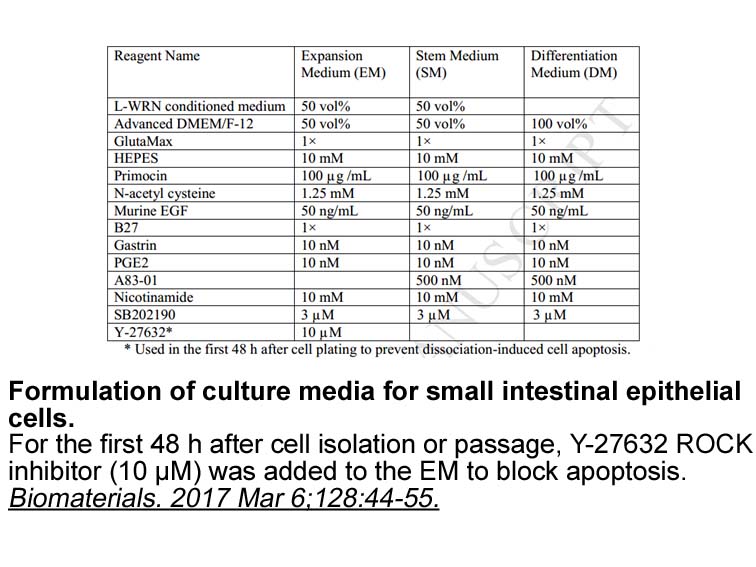Archives
br Role of autophagy in
Role of autophagy in alcoholic cardiomyopathy
Concluding remarks
The genetic and phenotypic heterogeneity in alcoholic cardiac injury has been recognized despite the seemingly beneficial effects of low to moderate alcohol consumption [8]. Although oxidative stress is well established in the pathogenesis of alcoholic cardiomyopathy [12,21,53,95], beneficial effects of the antioxidant components of red wine were hardly recapitulated in humans [4,6]. Given the apparent changes in autophagy in alcoholic cardiomyopathy and overwhelming knowledge of targeting autophagy in the management of cardiovascular diseases [10,21,26,33,63], further study is warranted to better understand the precise role of excessive autophagy (autosis) and regulation of autophagy by ethanol, acetaldehyde and oxidative stress in the pathogenesis and therapeutics of alcoholic cardiomyopathy. Ample human and genetically engineered murine studies have validated the essential role for ethanol metabolism in particular acetaldehyde in the onset and development of alcoholic cardiomyopathy [20,21,4 1,42]. As acetaldehyde may directly alter autophagy levels and shift the redox status in multiple organs [21], it is plausible to speculate the role of acetaldehyde as a check-point in the governance of autophagy in the onset and progression of alcoholic cardiomyopathy. Somewhat paradoxically, the autophagy inducer rapamycin may also be considered in the therapeutics of alcoholic cardiomyopathy through promoting autophagy and alleviating apoptosis [96]. Therefore, the role of autophagy in the pathogenesis of alcoholic cardiomyopathy may not be simply as the “face value” could suggest.
1,42]. As acetaldehyde may directly alter autophagy levels and shift the redox status in multiple organs [21], it is plausible to speculate the role of acetaldehyde as a check-point in the governance of autophagy in the onset and progression of alcoholic cardiomyopathy. Somewhat paradoxically, the autophagy inducer rapamycin may also be considered in the therapeutics of alcoholic cardiomyopathy through promoting autophagy and alleviating apoptosis [96]. Therefore, the role of autophagy in the pathogenesis of alcoholic cardiomyopathy may not be simply as the “face value” could suggest.
Transparency document
Odontoblasts constitute an important barrier to cariogenic bacterial infection , . The survival of these 20187 is significant for the prognosis of inflamed pulp . The results from our previous studies suggest that autophagy is essential for the anti-inflammatory response of odontoblasts .
Autophagy is evolutionary conserved; it degrades and recycles long-lived proteins and impaired organelles to preserve intracellular homeostasis , . The progression of autophagy includes the formation of the double-membrane vesicles that can expand into autophagosomes with the identification of numerous autophagy-related genes, such as LC3 and Atg5-Atg12, and subsequently fuse with lysosome to degrade the cargo , , . Autophagy is of importance in both physiological regulation and pathologic processes such as cancer, neurodegeneration, and inflammation , , . Autophagy is also implicated in tooth development and odontoblast aging . Our previous studies demonstrated autophagy plays a dual role in inflamed odontoblasts , which indicates its importance in maintaining the microenvironmental homeostasis of odontoblasts.
The mechanism of autophagy regulation is complicated. Previous studies reported several transcriptional factors including the FoxO family, TFEB, and CLOCK regulate autophagy in response to different external or internal stimulations , . For example, starvation can promote nuclear translocation of TFEB and induces autophagy by regulating lysosome biogenesis in HeLa cells , . However, the concrete transcription factors that are responsible for activating and regulating the inflammation-induced autophagy in odontoblasts have not been identified to date.
The Forkhead box O (FoxO) family has been studied extensively as vital transcriptional regulators of crucial proteins. The FoxO  family includes the FoxO1, FoxO3a, FoxO4, and FoxO6 subfamilies in mammalian cells . FoxO3a has been highlighted because of its pivotal regulation of immunity, longevity, metabolism, differentiation, and apoptosis , . FoxO3a can be phosphorylated and inactivated by PI3K/Akt . The knockdown of FoxO3a in tumor cells promotes proliferation and subsequently leads to cancer . In addition, the proapoptosis factor Bim is reported to be a direct downstream target of FoxO3a and initiates apoptosis , .
family includes the FoxO1, FoxO3a, FoxO4, and FoxO6 subfamilies in mammalian cells . FoxO3a has been highlighted because of its pivotal regulation of immunity, longevity, metabolism, differentiation, and apoptosis , . FoxO3a can be phosphorylated and inactivated by PI3K/Akt . The knockdown of FoxO3a in tumor cells promotes proliferation and subsequently leads to cancer . In addition, the proapoptosis factor Bim is reported to be a direct downstream target of FoxO3a and initiates apoptosis , .